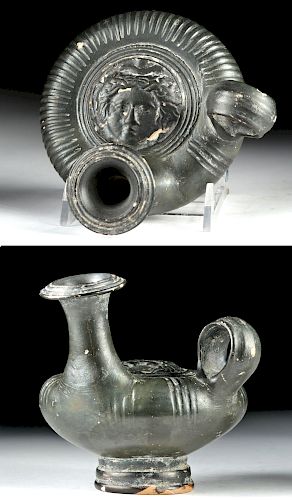Published Campanian Pottery Guttus w/ Medusa
Lot 36c
About Seller
Artemis Gallery
686 S Taylor Ave, Ste 106
Louisville, CO 80027
United States
Selling antiquities, ancient and ethnographic art online since 1993, Artemis Gallery specializes in Classical Antiquities (Egyptian, Greek, Roman, Near Eastern), Asian, Pre-Columbian, African / Tribal / Oceanographic art. Our extensive inventory includes pottery, stone, metal, wood, glass and textil...Read more
Estimate:
$900 - $1,400
Absentee vs Live bid
Two ways to bid:
- Leave a max absentee bid and the platform will bid on your behalf up to your maximum bid during the live auction.
- Bid live during the auction and your bids will be submitted real-time to the auctioneer.
Bid Increments
| Price | Bid Increment |
|---|---|
| $0 | $25 |
| $300 | $50 |
| $1,000 | $100 |
| $2,000 | $250 |
| $5,000 | $500 |
| $10,000 | $1,000 |
| $20,000 | $2,500 |
| $50,000 | $5,000 |
| $100,000 | $10,000 |
| $200,000 | $20,000 |
About Auction
By Artemis Gallery
May 22, 2019
Set Reminder
2019-05-22 10:00:00
2019-05-22 10:00:00
America/New_York
Bidsquare
Bidsquare : Exceptional Day 1: Antiquities Asian Fine Art
https://www.bidsquare.com/auctions/artemis-gallery/exceptional-day-1-antiquities-asian-fine-art-4129
Day 1 of an important 2-day auction featuring exceptional art from around the world - Egyptian, Greek, Etruscan, Roman, Viking, Russian, Near Eastern; Asian Art from China, Japan, Thailand, Vietnam, Burma, India; Fine Art from the 17th century to present. Artemis Gallery info@artemisgallery.com
Day 1 of an important 2-day auction featuring exceptional art from around the world - Egyptian, Greek, Etruscan, Roman, Viking, Russian, Near Eastern; Asian Art from China, Japan, Thailand, Vietnam, Burma, India; Fine Art from the 17th century to present. Artemis Gallery info@artemisgallery.com
- Lot Description
Magna Graecia, Southern Italy, Campania, ca. 360 to 320 BCE. A classic mold-formed pottery guttus (or guttos) with a rounded, ribbed body, a single loop handle with a shallow midrib, a high spout with an everted rim adorned with incised concentric rings, and a raised, tiered spool foot, all coated with a lustrous black glaze save for the underside of the foot. The tondo is decorated in low relief with the head of Medusa, the mythical female monster with venomous snakes for hair and a gaze which could instantly turn men into stone. The concept of a gorgon is at least as old as Homer and continued to be used as a monstrous symbol throughout the Roman and post-classical period, especially as decoration on pottery. Size: 4.6" W x 4.125" H (11.7 cm x 10.5 cm).
Exhibited in "Dressed to Kill in Love and War: Splendor in the Ancient World", February 1 - March 31, 2019, Academy Art Museum, Maryland, USA, published in the exhibition guide by Sarah E. Cox and Anke Van Wagenberg, fig. 2.
Provenance: private East Coast, USA collection; Exhibited and published in catalogue for "Dressed to Kill in Love and War: Splendor in the Ancient World" (February 1 - March 31, 2019 - Academy Museum, Easton, Maryland, USA, p. 8, fig. 2, discussion on pp. 5-6.
All items legal to buy/sell under U.S. Statute covering cultural patrimony Code 2600, CHAPTER 14, and are guaranteed to be as described or your money back.
A Certificate of Authenticity will accompany all winning bids.
We ship worldwide and handle all shipping in-house for your convenience.
#146253Minor nicks and abrasions to body, foot, handle, and spout, with chipping to glazing in some areas, and light excisions, otherwise intact and very good. Light earthen deposits as well as faint silvery and rainbow iridescence throughout. Old inventory label beneath foot.Condition
- Shipping Info
-
All shipping is handled in-house for your convenience. Your invoice from Artemis Gallery will include shipping calculation instructions. If in doubt, please inquire BEFORE bidding for estimated shipping costs for individual items.
-
- Buyer's Premium



 EUR
EUR CAD
CAD AUD
AUD GBP
GBP MXN
MXN HKD
HKD CNY
CNY MYR
MYR SEK
SEK SGD
SGD CHF
CHF THB
THB
















